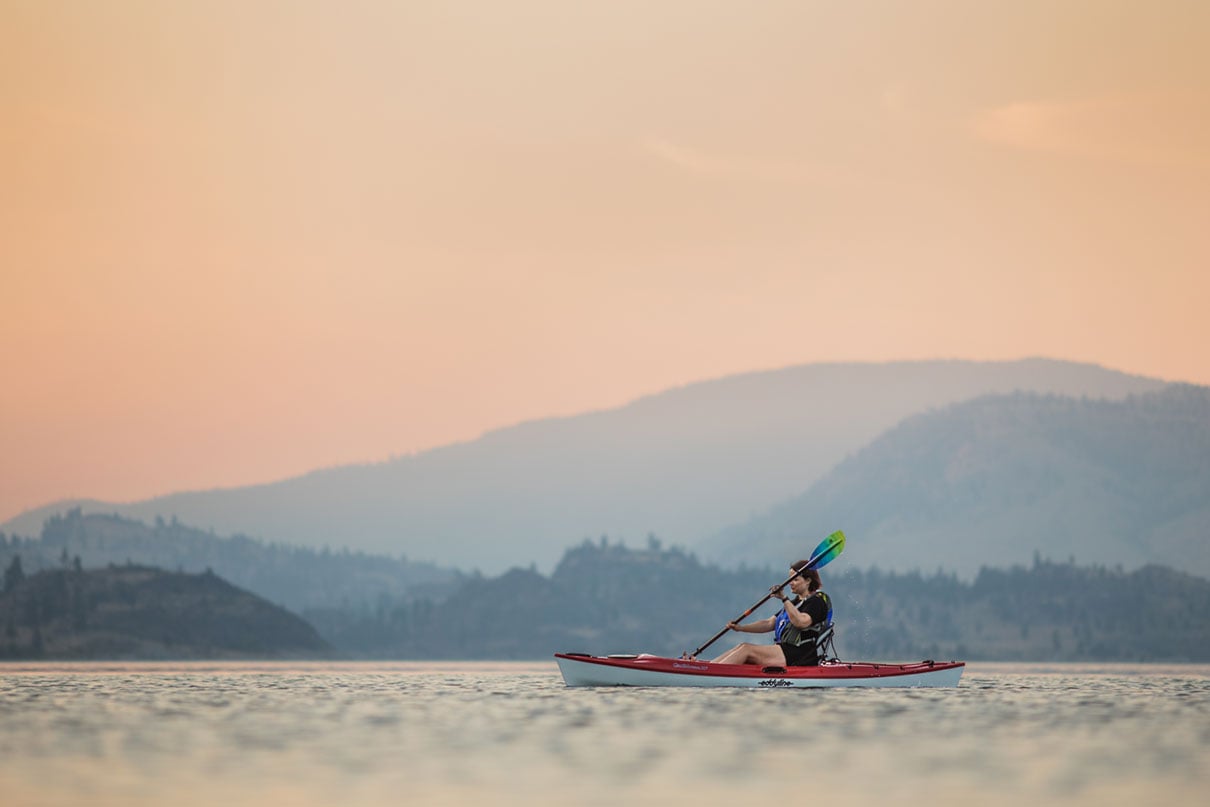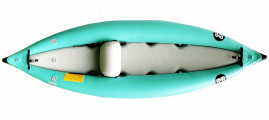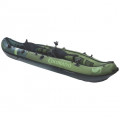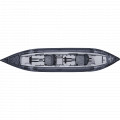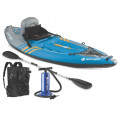Inflatable kayaks come in a huge variety of styles, suited to everything from tame pond paddles to extreme expeditions and whitewater. By definition, these boats are lightweight and easy to store and transport, making them perfect for those with limited storage space, travelers and people who rely on public transit.
There’s a vast price range in inflatable kayaks, from cheap, $100 inflatable kayaks at Walmart to more advanced models with rigid internal frames for greater efficiency, specialized pedal-drive inflatable kayaks and inflatables meant for whitewater performance.
Portability is the name of the game when it comes to inflatable kayaks. The best inflatable kayaks pack into a reasonably-sized duffel and set up in minutes. In general, inflatable kayaks are also significantly lighter than rigid kayaks. However, an air-filled kayak will never cut through the water as smoothly as a rigid kayak, and performance is the main drawback of this style of kayak.
Before you buy you must carefully weigh your desire for ultimate portability versus performance; after that, price and where you buy (box store or paddlesports retailer) reflects the quality of the inflatable kayak.
This inflatable kayak guide will help you understand all the options in inflatable kayak design and construction so you can make an informed decision and choose the right boat for your needs.
Top picks: Best inflatable kayaks for 2025
The following inflatable kayaks have received the highest star ratings by reviewers in our Paddling Buyer’s Guide. See and review all inflatable kayaks here.
Best Inflatable Kayaks

AdvancedFrame Expedition Elite Kayak with Pump
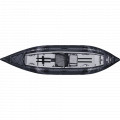
Blackfoot Angler 130
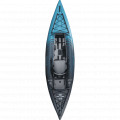
Chelan 120
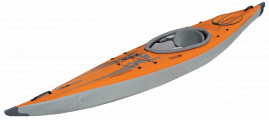
AirFusion EVO
Shop inflatable kayaks
The links in this section will take you to our comprehensive Paddling Buyer’s Guide, where you’ll find all the best inflatable kayaks on the market, including reviews, ratings and where to buy. You can choose to filter kayaks by type and application, such as fishing or whitewater, or by the number of paddlers (one-person or tandem), and so much more.
Then, click on specific models to see specs, prices, reviews and where to buy. We’ve also narrowed down the best kayaks at the most popular retailers including sporting goods stores, outdoors stores and big box department and hardware stores. You simply will not find a better kayak buyer’s guide resource on the web.
Best inflatable kayaks
Interested in a particular type or brand of inflatable kayak and want to learn more before you buy? Below you’ll find our articles about more specific types and brands of inflatable kayaks.
- Best Inflatable Two-Person Kayaks For 2025
- Best Inflatable Kayaks At Walmart For 2025
- Best Inflatable Fishing Kayaks For 2025
Shopping for a used inflatable kayak?
Think you’ve scored a great deal on an inflatable kayak on Craigslist? You’ll find plenty of used inflatable kayaks listed on buy-and-sell websites like Craigslist, Kijiji and Facebook Marketplace. There’s a huge range of quality in inflatable kayaks so your first step in making a good investment is to research the specific attributes of the used inflatable kayak you are considering.
Our Paddling Buyer’s Guide provides an exhaustive database of every kayak on the market, making this the ideal place to start. If you decide your Craigslist inflatable kayak is a true contender, consider the following advice to make a good used inflatable kayak purchase:
- Buy the right type of used inflatable kayak for your paddling preferences by researching the particular model in advance to determine whether or not it truly meets your needs.
- Give the used inflatable kayak a once-over, looking for damage to the hull (bottom), deck (top) and outfitting (seat, back rest, foot pegs, etc). Inflatable kayaks need to be airtight to remain buoyant, so it’s a good idea to set up the kayak and apply gentle pressure to the air tubes, listening for leaks. Be sure to inspect the valves, too.
- Try to determine how the kayak was stored. An inflatable kayak that was stored outdoors in the sun is subject to damaging UV radiation, which weakens the kayak’s structure. Look for fading, a solid indicator of UV damage. Check for staining and mold on the inflatable kayak as well; these are clear indicators that the kayak was stored wet, which may compromise the integrity of the boat.
- Taking the kayak for a test paddle is the best way to find out whether the kayak works for you in terms of performance, handling, comfort and fit.
For more tips on what to look for when selecting a used kayak, read our article How To Buy A Used Kayak.
Inflatable kayak buying guide
The question, “should I get an inflatable kayak?” is a great starting point in finding the right kayak for you. Choosing an inflatable kayak begins with a knowledge of this style of kayak’s strengths and weaknesses. Inflatable kayaks are highly portable watercraft that can be inflated for use and deflated for storage and ease of transport. Many inflatable kayaks consist of three air chambers—a floor chamber and two side chambers—though there are many designs available. Inflatable boats can be filled using a foot pump, hand pump or electric pump.
Wondering what to look for in an inflatable kayak? There are inflatable kayak models available for almost every kayaking activity or experience level. In general, they are best suited for people who value the benefits afforded by their compactness. For example, someone who wants to access hard-to-reach launch points would enjoy the fact that an inflatable kayak can be easily carried over rough terrain and for longer distances.
Likewise, someone who lives in an apartment would appreciate that it can be stored in a small space. They’re also great for travelers who wish to bring their own kayak to exotic destinations. Some of the cheapest kayaks on the market are also inflatables, so they’re often favored by casual paddlers on a tight budget.
There are distinct advantages and disadvantages to inflatable kayaks when compared to their rigid kayak counterparts or even other portable options such as foldable kayaks. You’ll need to weigh these pros and cons against each other based on what kayak features are important to you.
Keep in mind that regardless of whether you go the inflatable, foldable or rigid route, there’s a wide range of quality on the market. It’s important you do your research and purchase from a reputable brand to ensure you’re making a wise investment, but more importantly to ensure your safety on the water.
Inflatable kayaks have numerous benefits: they’re light, compact, often cheap, durable, versatile for many types of recreational, fishing and whitewater paddling, and often comfortable and super stable. On the downside, their air-filled hulls do not cut through the water as efficiently as a rigid kayak, and they can also be harder to handle in wind and waves.
The durability of inflatable kayaks is two-fold. First, the PVC rubber used in inflatable kayaks is tough and resilient to abrasion; welded seams add to the overall durability. Second, inflatable kayaks are extremely resistant to impact; they literally bounce off of rocks. More advanced models add stiffness to the hull with aluminum frames and drop stitching, a construction method that allows you to increase the air pressure of the hull. Both frames and drop stitching create a stiffer inflatable kayak that slices through the water more efficiently—usually with a higher price tag.
The majority of inflatable kayaks are recreational kayaks, meant for casual paddling on calm and sheltered water. A few day touring and smaller expedition inflatable kayaks are also available for those looking for something more efficient for longer distance trips. Inflatable fishing kayaks are also quite popular, and you’ll find models with all the bells and whistles (think: rod holders and mounts for fish-finders and action cameras) that anglers love.
Hobie manufactures a unique lineup of portable inflatable pedal kayaks for a different experience on the water. Finally, inflatable whitewater kayaks use the same rugged construction and self-bailing technology as whitewater rafts for durability and control in rapids.
Take the time to do your homework and be sure to try as many inflatable kayaks as possible before you commit to a purchase. Here’s a list of other common questions that may help you in buying the best inflatable kayak.
-
Are inflatable kayaks safe?
Like any kayak, inflatable kayaks are safe when used in the appropriate water and weather conditions by paddlers with good judgment. It’s important to note that most inflatable kayaks are only suitable for sheltered and calm conditions. Look for a specialty inflatable kayak (often with a much higher price tag) if you’re looking for an inflatable kayak that’s safe in more advanced paddling conditions—and make sure you’re trained to handle these conditions, too.
Inflatable kayaks are designed with multiple air tubes to ensure buoyancy even if one tube is punctured; similarly, the open deck of most inflatable kayaks facilitates safe and easy entry and exit. However, inflatable kayaks tend to be more impacted by wind and waves, making them more hazardous in open water conditions.
-
Are inflatable kayaks good?
There’s a huge range of inflatable kayaks available; if your first priority is a compact and highly portable kayak, you’ll find plenty of good options available. As with any consumer product, price is often a good indicator of overall quality. This matters if you’re seeking the very best inflatable kayak, however there are many solid budget-friendly inflatable kayaks available for casual paddlers.
-
Are inflatable kayaks worth it?
Inflatable kayaks are worth it if you’re limited on storage space and/or don’t want to invest in a roof rack (or a truck) to transport a kayak. On the other hand, if you have good storage options, want a kayak that doesn’t require assembly and are looking for something with better performance, you are probably better off with a rigid kayak.
-
Do inflatable kayaks work?
Inflatable kayaks work well for certain types of paddlers. They’re great for those with limited storage space and/or you don’t want to invest in roof racks or a truck to transport a kayak. Inflatable kayaks also work well for travelers, allowing you to venture to exotic destinations without the need to rent a kayak.
-
Inflatable kayak cons
Inflatable kayak cons come down to performance: their air-filled hulls do not cut through the water as efficiently as a rigid kayak, and they can also be harder to handle in wind and waves. They also require a bit of setup time at the launch, using either a hand, foot or electric pump to inflate.
-
Inflatable kayak vs hardshell
The question of inflatable kayak vs hardshell comes down to portability vs performance. Do you lack storage space or want a highly portable kayak? Go inflatable. If you have access to storage, a hardshell offers far better performance.
-
Folding vs inflatable kayak
Folding kayaks bridge the gap between rigid kayaks and inflatable kayaks. They’re just as portable and easy to store as inflatables, but with performance characteristics approaching those of a hardshell kayak. However, they’re often more expensive than either a rigid kayak or an inflatable kayak.
-
Inflatable kayak vs SUP
Inflatable kayak vs SUP comes down to whether or not you want to use a double-bladed paddle (kayak) and paddle sitting down, or a single-bladed paddle (SUP) and paddle standing up. In general, inflatable kayaks are easier for novices. However, performance-wise, a quality inflatable SUP is stiffer and paddles more efficiently than an inflatable kayak. The question comes down to which style of paddling you prefer.
-
Types of inflatable kayaks
The majority of inflatable kayaks fall into two categories: Recreational or fishing. Recreational inflatable kayaks are cheap, stable and easy to paddle, although slow and best suited to sheltered conditions. Fishing inflatable kayaks have similar performance characteristics, but with the addition of fishing-specific accessories such as rod holders and tackle storage areas.
Day touring inflatable kayaks are also available, with additional length for greater glide and performance, as well as more storage space for gear. You will find all of these types of inflatable kayaks available in single- and double-person models, with a few manufacturers producing specialty models that will fit three or even four paddlers.
-
Best inflatable kayak material
Wondering, what are inflatable kayaks made of? In general, inflatable kayaks are made of PVC plastic with welded seams. This is a durable, time-tested plastic for inflatable boats. PVC boats resist impact and abrasion. Multiple air tubes ensure that the kayak will remain floating even if one chamber is punctured. The primary point of failure is often the kayak inflation valve system, so be sure to treat these parts carefully.
-
Inflatable kayak size
Inflatable kayaks are available in a similar size range to rigid recreational kayaks. Shorter models around eight feet are most maneuverable and suitable for paddling on twisting rivers (check out AIRE kayaks if you’re looking for an inflatable whitewater kayak). A 10-foot inflatable kayak makes a good all-around boat, with easy maneuverability and handling for single paddlers.
Longer 12- to 14-foot inflatable kayaks have the space for tandem paddling and offer more glide and better tracking (the kayak’s tendency to paddle in a straight line) than shorter boats. Ultimately, the decision comes down to where you’ll be using the kayak (river or open water) and the number of paddlers on board.
-
Best brand of inflatable kayak
There are several recommended brands of inflatable kayak available. Sevylor is a common brand offering cheap inflatable kayaks, with models that are well suited to casual paddlers and kayak anglers in calm and sheltered locations. Sea Eagle and Advanced Elements make slightly pricier models, with enhanced features like drop-stitched floors for added stiffness and internal aluminum frames to improve the kayak’s efficiency and performance.
AIRE makes some of the best inflatable whitewater kayaks, with versatile designs for river paddling. Hobie iTrek is a unique line of fun and responsive pedal-driven inflatable kayaks for recreational use and fishing.
-
Where to buy inflatable kayak
Inflatable kayaks are often available at discount big box stores like Walmart and Costco. You’ll also find cheap, entry level inflatable kayaks for sale on Amazon. Shop at outdoors and sporting goods stores for somewhat better designs. And for the best-performing inflatable kayak (and specialized models with features like pedal-drive) visit a paddlesports specialty store.
-
How much does an inflatable kayak weigh?
Inflatable kayaks tend to be amongst the lightest recreational and fishing kayaks available. While they’re not quite as light as air, a typical one- or two-person inflatable kayak weighs under 40 pounds and deflates into a large duffel.
-
Inflatable kayak weight capacity
Each model of inflatable kayak will have its own recommended weight capacity. In general, look for a larger model for greater capacity. The air-filled hull of an inflatable kayak adds buoyancy and increases overall capacity compared to hard-shell kayaks.
-
How long do inflatable kayaks last?
Inflatable kayaks are durable and long-lasting as long as they’re properly stored. Leaving an inflatable kayak in direct sunshine will quickly cause its PVC material to deteriorate and crack. Similarly, storing a wet inflatable kayak will lead to mildew and mold.
-
Can inflatable kayaks pop?
Inflatable kayaks can pop if they’re left fully inflated in hot sunshine, though this sort of incident is rare. Be sure to leave your inflated kayak in the shade on hot days and monitor the air pressure in the tubes. You can also pop an inflatable kayak through over-inflation; check the recommended air pressure and don’t use an air compressor to inflate.
-
Are inflatable kayaks slower?
The flexible, air-filled hulls of inflatable kayaks make them slower than rigid kayaks. Some models feature internal aluminum frames for added stiffness, though the hull will always flex a bit and be less efficient at cutting through the water. This is a compromise for the supreme portability of inflatable kayaks.
-
Inflatable kayak speed
Inflatable kayak speed depends on the technique of the paddler and the design of the kayak. In general, the longer and narrower the kayak, the faster and more efficiently it will cut through the water. However, an inflatable kayak will never cut through the water as efficiently and fast as a rigid kayak. Often the designs are meant to enhance portability, with compact dimensions that further compromise paddling speed.
-
Durability of inflatable kayaks
In general, inflatable kayaks are made of PVC plastic with welded seams. This is a durable, time-tested plastic for inflatable boats. PVC boats resist impact and abrasion. Multiple air tubes ensure that the kayak will remain floating even if one chamber is punctured. The primary point of failure is often the kayak inflation valve system, so be sure to treat these parts carefully.
-
Inflatable kayak price
There’s no set answer to the common question, How much are inflatable kayaks? The price of inflatable kayaks varies by quality of the kayak and location of purchase. For example, inflatable kayaks are some of the cheapest kayaks sold at big box stores like Walmart, often starting around $100.
Better quality inflatable kayaks are available for under $1,000. At the far end of the price range, a specialized Hobie pedal-powered iTrek inflatable kayak (sold at paddlesports retail stores) costs $2,449 USD to $5,399 USD.
-
Are inflatable kayaks hard to paddle?
Inflatable kayaks are easy to paddle, though they are slow and inefficient compared to hard-shell kayaks. Inflatable kayaks are extremely stable and comfortable, however their greater width can make paddling less comfortable for shorter people. Tracking (ability to travel in a straight line and handle cross-winds and waves) is also a concern in some cheaper inflatable kayaks.
-
Can a dog ride in an inflatable kayak?
In most cases you’ll want a two-person, open-deck inflatable kayak to accommodate your dog for short paddling trips. Before you set off on a paddle with your dog make sure having Fido on board doesn’t compromise your ability to paddle or enter and exit the kayak.
Also, bear in mind that your dog’s sudden movement could compromise your stability and lead to a capsize, so be sure to limit your “dog paddles” to calm conditions and sheltered locations.
-
How stable are inflatable kayaks?
Inflatable kayaks are extremely stable. Most models feature broad, flat bottoms that make them extremely resistant to capsizing, while the air-filled hull conforms to the surface of the water to flex with waves. However, this design also makes the kayak slower and more sluggish to paddle.
-
Where can I use an inflatable kayak?
Inflatable kayaks can be used in many locations, depending on the make and model. Cheaper recreational and fishing inflatable kayaks are meant for use in calm, sheltered locations. Be sure to research the specific model of inflatable kayak to determine whether or not it’s suitable for your paddling needs. The Paddling Buyer’s Guide is a great place to start.
-
Can you use an inflatable kayak on the ocean?
Some inflatable kayaks can be used on the ocean; it all depends on the model and the location you will be paddling. Be sure to research the specific model of inflatable kayak to determine whether or not it’s suitable for your paddling needs. The Paddling Buyer’s Guide is a great place to start.
-
Are inflatable kayaks OK for rivers?
Some inflatable kayaks are suitable for rivers; it all depends on the model. Be sure to research the specific model of inflatable kayak to determine whether or not it’s suitable for river use. The Paddling Buyer’s Guide is a great place to start.
-
Can I put a trolling motor on my inflatable kayak?
There are some inflatable fishing kayaks which accept trolling motors. More often than not, adding an electric trolling motor is a DIY upgrade. Research the specific inflatable kayak model and check out YouTube for how-to tutorials. Make sure that adding a trolling motor doesn’t upset the balance of the kayak or make it harder to enter or exit.
-
Do I need a license for an inflatable kayak?
You do not need to obtain a license for an inflatable kayak in Canada. However, licenses are required in some U.S. states. In these locations, the licensing requirement is sometimes determined by where you will use the kayak (such as DNR areas) and whether or not you have a trolling motor.
Inflatable kayak reviews
Once you have a general idea of what type or brand of inflatable kayak you are most interested in, turn to our expert reviews to help you narrow your options even further. Our reviewers go over performance, comfort, accessories and more to help you decide whether a kayak is the right match for your paddling pursuits.
- Inflatable Kayak Review: AIRE’s Spud & Tater
- Inflatable Kayak Review: Tobin Wavebreak
- Inflatable Recreational Kayak Review: Intex Challenger K1
- Inflatable Kayak Review: Sevylor Colorado
- Inflatable Hybrid Review: TAHE Beach SUP-YAK
- Inflatable Recreational Kayak Review: Intex Challenger K2
- Inflatable Recreational Kayak Review: Intex Explorer K2
- Inflatable Pedal Kayak Review: BOTE LONO Aero Apex
- Inflatable Kayak Review: Sea Eagle 370
- Hobie Mirage i11S Inflatable Kayak-Paddleboard Hybrid Review



